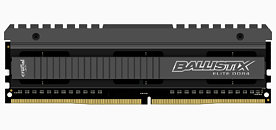Monday, June 2nd 2014

Crucial Announces Ballistix Elite DDR4 Memory
Crucial, a leading global brand of memory and storage upgrades, today announced new Crucial Ballistix Elite DDR4 memory modules, which deliver the next generation of memory to high performance gaming. Designed for gamers and enthusiasts, Ballistix Elite DDR4 memory delivers introductory speeds that start at 2666 MT/s and 3000 MT/s and is expected to get faster as the technology matures.
The new modules offer nearly twice the bandwidth of mainstream DDR3 memory at up to 24 GB/s, and deliver improved system responsiveness and increased frame rates. Furthermore, Ballistix Elite DDR4 memory delivers up to 40 percent more power efficiency than standard DDR3 memory.Designed for the ultimate gaming experience, Ballistix Elite DDR4 modules are optimized for next-generation Intel X99 platforms with support for XMP 2.0 profiles. The new modules also introduce a new design to the Ballistix line-up, featuring an aggressively styled anodized aluminum heat spreader for improved heat dissipation on a custom-designed black PCB. Supported by the Ballistix Memory Overview Display (M.O.D.) utility, an integrated thermal sensor allows for real-time temperature monitoring which aids in overclocking efforts.
"Gamers and enthusiasts push their systems to the limit and are always looking for ways to reduce bottlenecks," said Jeremy Mortenson, product marketing manager, Crucial. "With the introduction of Ballistix DDR4, the fastest memory speeds and bandwidths are now more accessible. Along with making peak performance attainable, Ballistix DDR4 also sets up gamers and enthusiasts for the next wave of performance that will only be possible with newer platforms using DDR4."
Available in 4 GB and 8 GB modules, as well as 8 GB, 16 GB, and 32 GB kits, Ballistix Elite DDR4 memory will be available for purchase from crucial.com and through select global partners in August 2014. Crucial DDR4 desktop memory will also be available in August in four channel kits up to 32 GB with introductory speeds of 2133MT/s. All Crucial memory is backed by a limited lifetime warranty.* For more information about Crucial DDR4 memory, visit www.crucial.com/usa/en/memory-ddr4-info.
The new modules offer nearly twice the bandwidth of mainstream DDR3 memory at up to 24 GB/s, and deliver improved system responsiveness and increased frame rates. Furthermore, Ballistix Elite DDR4 memory delivers up to 40 percent more power efficiency than standard DDR3 memory.Designed for the ultimate gaming experience, Ballistix Elite DDR4 modules are optimized for next-generation Intel X99 platforms with support for XMP 2.0 profiles. The new modules also introduce a new design to the Ballistix line-up, featuring an aggressively styled anodized aluminum heat spreader for improved heat dissipation on a custom-designed black PCB. Supported by the Ballistix Memory Overview Display (M.O.D.) utility, an integrated thermal sensor allows for real-time temperature monitoring which aids in overclocking efforts.
"Gamers and enthusiasts push their systems to the limit and are always looking for ways to reduce bottlenecks," said Jeremy Mortenson, product marketing manager, Crucial. "With the introduction of Ballistix DDR4, the fastest memory speeds and bandwidths are now more accessible. Along with making peak performance attainable, Ballistix DDR4 also sets up gamers and enthusiasts for the next wave of performance that will only be possible with newer platforms using DDR4."
Available in 4 GB and 8 GB modules, as well as 8 GB, 16 GB, and 32 GB kits, Ballistix Elite DDR4 memory will be available for purchase from crucial.com and through select global partners in August 2014. Crucial DDR4 desktop memory will also be available in August in four channel kits up to 32 GB with introductory speeds of 2133MT/s. All Crucial memory is backed by a limited lifetime warranty.* For more information about Crucial DDR4 memory, visit www.crucial.com/usa/en/memory-ddr4-info.

19 Comments on Crucial Announces Ballistix Elite DDR4 Memory
BRAND NEW STANDARD IS MISSING PROPER SPD TABLES??! wtf
Here... you Aren't crazy. i.imgur.com/zZAg0O5.jpg
(CAS / Frequency (MHz)) × 1000 = X ns
;)
Personally I will be waiting as long as possible for true DDR4 modules, the ones starting from
4GHz and above.
It's that 1.2v thing. Just wait until low voltage DDR4 comes out that runs at what... 1.05v? Improvements are being made in the right places. It's not like CPUs are struggling because of memory bottlenecks.
Is it that thing with the increasing number of compute cores bolted on to it? Because, yeah, sorry...that statement is just wrong.
The only CPUs lately that have been truly taking advantage of DRAM speeds are the iGPU side of AMD's APU.
Sorry, but my statement isn't wrong, but you presuming to know what you're talking about when you obviously don't is wrong. Do some benchmarks and find out for yourself.
X99 with HW-E gets DDR4 but they also are getting 8 core unlocked chips. Though I would be unsurprised if like X79 the Xeons with more cores didn't work on it.
There are plenty of applications that need more memory bandwidth than dual channel allows... but they typically also need more than 4 cores.
Gaming isn't one of them yet.